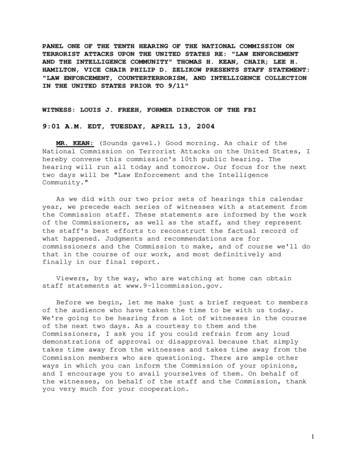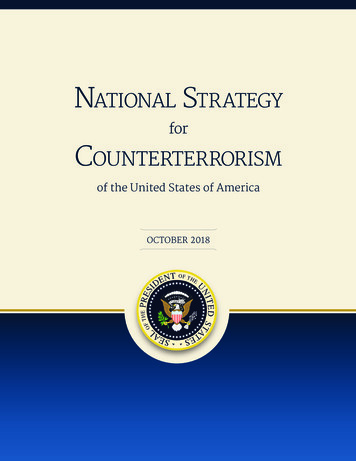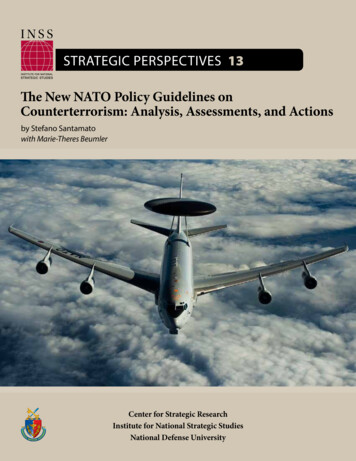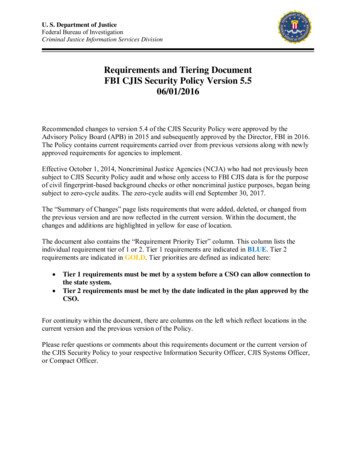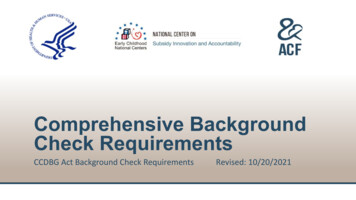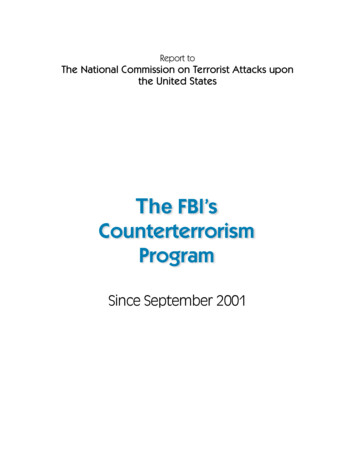
Transcription
Report toThe National Commission on Terrorist Attacks uponthe United StatesThe FBI’sCounterterrorismProgramSince September 2001
TABLE OF CONTENTSIIIIIIIVVEXECUTIVE SUMMARY.11FBI ORGANIZATIONAL CHART. 33TIMELINE OF SIGNIFICANT REFORMS ANDINITIATIVES SINCE 9/11/01. 44INTRODUCTION.66PRIORITIZATION.77The New Priorities.771 Protect the United States from Terrorist Attack.772 Protect the United States Against Foreign Intelligence Operations andEspionage.773 Protect the United States Against Cyber-based Attacks andHigh-Technology Crimes.884 Combat Public Corruption at all Levels.885 Protect Civil Rights.886 Combat Transnational/National Criminal Organizations and Enterprises.887 Combat Major White-Collar Crime.888 Combat Significant Violent Crime.889 Support Federal, State, Municipal, and International Partners.9910 Upgrade Technology to Successfully Perform the FBI's Mission.99Implementing the New Priorities.991 Communication of Priorities.992 Priorities in the Budgetary Process.10103 Enforcement of Priorities.1111VIMOBILIZATION.1212Personnel Mobilized.12Expanded Operational Capabilities.131 Counterterrorism Watch.13132 National Joint Terrorism Task Force.143 Terrorism Financing Operations Section.154 Evidence Exploitation.165 Fly-Away/Rapid Deployment Teams.166 Foreign Terrorist Tracking Task Force.167 Bioterrorism Risk Assessment Group.178 Foreign Intelligence Surveillance Act Unit.179 Language Translation.1710 Special Technologies and Applications Section.1811 Investigative Technology Division.19
VIICENTRALIZATION.2020Investigative Operations Branch.212122Operational Support Branch.22Counterterrorism Analysis Branch.2222VIII INTELLIGENCE INTEGRATION.232323Integrating Criminal and Intelligence Operations.23Integrating Intelligence Processes in our Operations.24241 Initial Deployment of Analysts.25252 Office of Intelligence.25253 Intelligence Program.252526EAD Intelligence.2626Concepts of Operations.2628Field Office Intelligence Operations.Requirements Process.2828Baselining of Sources.2929Analytical Assets.29Intelligence Production Board.3030314 Intelligence Workforce.31Recruitment.3131Special Agents Career Track.3131Training.3232Program Evaluations.3434Special Agent Evaluations.353536Evaluation of Special Agents in Charge.36IXCOORDINATION.373737State and Municipal Law Enforcement.371 Task Forces.3838392 Office of Law Enforcement Coordination.39393 Terrorist Screening Center.39404 Law Enforcement Online.40415 Alert Notification System.41416 Intelligence Bulletins.41417 Information Sharing Pilot Projects.418 Security Clearances.4141429 New Counterterrorism Training Initiatives.424310 Behavior Analysis Unit.434311 Regional Computer Forensic Laboratory Program.4343Intelligence Community. .1 Terrorist Threat Integration Center. 432 Exchange of Personnel. 443 Joint Briefings. . 444 Secure Networks. . 44
5 Compatability of Information Technology Systems.44446 Terrorist Explosive Device Analytical Center.45Department of Homeland Security.4545Foreign Governments .46461 International Investigations.46462 Expansion of Legal Attaché Offices.46463 Joint Task Forces and Operations.47474 Fingerprint/Identification Initiatives.47475 International Training Initiatives.4848Private Sector .49491 Community Outreach.49492 Infragard.4949503 Financial Sector Outreach.50504 Railroad Initiative.50XINFORMATION TECHNOLOGY.51Centralized Management.5151Trilogy.5252Data Warehousing.5353Analytical Tools.5454Putting It All Together.5656XI ADMINISTRATIVE REFORM.5757Strategic Planning.5757Realigning the Workforce.57571 Revised Personnel Selection Process .58582 Streamlined Hiring Process.5959Training. 59Executive Leadership Initiatives.5959Records Management.6060601 Centralizing Records Management.602 Turning Paper into Searchable Data.60603 New Records Control Schedule.61614 Improving Efficiency.6161
Security Management.611 Information Assurance Plan.612 Enterprise Operations Center. .613 Audits and Reviews. 62624 Security Officers. 5 Security Education.62626 Disaster Recovery Planning. XIIASSESSMENT OF OUR PROGRESS.63Development of Human Assets.63Number of FISAs .64Number of Intelligence Reports Generated.64Quality of Daily Counterterrorism Briefings.65Effectiveness of Counterterrorism Operations.67Respect for Civil Liberties.70701 Statutory Limitations.71712 Oversight Mechanisms.71713 Self Regulation and Enforcement.72XIIICONCLUSION.7474DIRECTOR’S NOTE.74
Executive SummarySince the horrific attacks of September 11, 2001, the men and women of the Federal Bureau ofInvestigation (FBI) have implemented a comprehensive plan that fundamentally transforms theorganization to enhance our ability to predict and prevent terrorism. We overhauled ourcounterterrorism operations, expanded our intelligence capabilities, modernized our businesspractices and technology, and improved coordination with our partners.Our plan consists of seven basic elements:1 PrioritizationWe replaced a priority system that allowed supervisors a great deal of flexibility with a set of 10priorities that strictly govern the allocation of personnel and resources in every FBI program andfield office. Counterterrorism is now our overriding priority, and every terrorism lead is addressed,even if it requires a diversion of resources from other priority areas.2 MobilizationTo implement these new priorities, we increased the number of Special Agents assigned toterrorism matters and hired hundreds of intelligence analysts and translators. We also establisheda number of operational units that give us new or improved capabilities to address the terroristthreat. These include the 24/7 Counterterrorism Watch and the National Joint Terrorism TaskForce to manage and share threat information; the Terrorism Financing Operation Section tocentralize efforts to stop terrorist financing; document/media exploitation squads to exploitmaterial found overseas for its intelligence value; deployable “Fly Teams” to lend counterterrorismexpertise wherever it is needed; and the Terrorist Screening Center and Foreign Terrorist TrackingTask Force to help identify terrorists and keep them out of the United States (U.S.).3 CentralizationWe centralized management of our Counterterrorism Program at Headquarters to limit “stovepiping” of information, to ensure consistency of counterterrorism priorities and strategy acrossthe organization, to integrate counterterrorism operations here and overseas, to improvecoordination with other agencies and governments, and to make senior managers accountablefor the overall development and success of our counterterrorism efforts.4 Intelligence IntegrationWe are building an enterprise-wide intelligence program that has substantially improved ourability to strategically direct our intelligence collection and to fuse, analyze, and disseminate ourterrorism-related intelligence. After the USA PATRIOT Act, related Attorney General Guidelines,and the ensuing opinion by the Foreign Intelligence Surveillance Court of Review removed thebarrier to sharing information between intelligence and criminal investigations, we quicklyimplemented a plan to integrate all our capabilities to better prevent terrorist attacks. We then1
elevated intelligence to program-level status, putting in place a formal structure and conceptsof operations to govern FBI-wide intelligence functions, and establishing Field Intelligence Groupsin every field office. We recently issued a series of new procedures that fundamentally transformour approach to hiring, training, and career development to cultivate and instill a capacity andunderstanding of intelligence processes and objectives within the entire Bureau workforce.5 CoordinationUnderstanding that we cannot defeat terrorism without strong partnerships, we have enhancedthe level of coordination and information sharing with state and municipal law enforcementpersonnel. We expanded the number of Joint Terrorism Task Forces, increased technologicalconnectivity with our partners, and implemented new ways of sharing information through vehiclessuch as the Intelligence Bulletin, the Alert System, and the Terrorist Screening Center. Toimprove coordination with other federal agencies and members of the Intelligence Community,we joined with our federal partners to establish the Terrorist Threat Integration Center, exchangedpersonnel, instituted joint briefings, and started using secure networks to share information. Wealso improved our relationships with foreign governments by building on the overseas expansionstarted under Director Louis Freeh; by offering investigative and forensic support and training;and by working together on task forces and joint operations. Finally, we expanded outreach tominority communities, and improved coordination with private businesses involved in criticalinfrastructure and finance.6 Information TechnologyWe are making substantial progress in upgrading our information technology to streamline ourbusiness processes and to improve our ability to search for and analyze information, drawconnections, and share it both inside the Bureau and out. We deployed a secure high-speednetwork, put new or upgraded computers on desktops, and consolidated terrorist informationin a searchable central database. We developed, and are preparing to launch, the Virtual CaseFile, a state-of-the-art case management system that will revolutionize how the FBI does business.7 Administrative ReformRe-engineering efforts are making our bureaucracy more efficient and more responsive tooperational needs. We revised our approach to strategic planning, and we refocused ourrecruiting and hiring to attract individuals with skills critical to our counterterrorism and intelligencemissions. We developed a more comprehensive training program and instituted new leadershipinitiatives to keep our workforce flexible. We are modernizing the storage and management ofFBI records. We also built, and continue to improve, an extensive security program withcentralized leadership, professional security personnel, more rigorous security measures, andimproved security education and training.These improvements have produced tangible and measurable results. We significantly increasedthe number of human sources and the amount of surveillance coverage to support our counterterrorismefforts. We developed and refined a process for briefing daily threat information, and we considerablyincreased the number of FBI intelligence reports produced and disseminated. Perhaps mostimportant, since September 11, 2001, we have participated in disrupting dozens of terroristoperations by developing actionable intelligence and better coordinating our counterterrorismefforts.It is a testament to the character and dedication of the men and women of the FBI that they haveimplemented these reforms and realized this progress, while continuing to carry out their responsibilityto investigate and protect America from criminal, counterintelligence, and terrorist threats of virtuallyunprecedented dimensions.2
FEDERAL BUREAU OF INVESTIGATIONCHIEF OF STAFFINSPECTION DIVISIONOFFICE OF PUBLIC AFFAIRSDIRECTORSAC ADVISORYCOMMITTEECONGRESSIONAL AFFAIRS OFFICEOFFICE OF THE OMBUDSMANDEPUTYDIRECTOROFFICE OF GENERAL COUNSELOFFICE OF EQUAL EMPLOYMENT OPPORTUNITYCHIEF INFORMATION OFFICEROFFICE OF PROFESSIONAL RESPONSIBILITYExecutive AssistantDirector forINTELLIGENCEExecutive AssistantDirector forCOUNTERTERRORISM/COUNTERINTELLIGENCEExecutive AssistantDirector forCRIMINALINVESTIGATIONSExecutive AssistantDirector forLAW ENFORCEMENT SERVICESOFFICE OF LAWENFORCEMENTCOORDINATIONExecutive AssistantDirector forADMINISTRATIONOFFICE OFSTRATEGICPLANNINGOFFICE CRITICAL INCIDENTRESPONSE ESTIGATIVEDIVISIONTRAININGDIVISIONCRIMINAL JUSTICEINFORMATIONSERVICES IONSECURITYDIVISIONINFORMATIONRESOURCESDIVISION
4
5
INTRODUCTIONDuring the past 31 months, the FBI has undergone a transformation in all areas of its operations.The transformation has involved both the institution of new functions and capacities as well asrefinements of existing processes and programs to modernize our operations. This report providesan overview of that reform process.We have always had responsibility for the counterterrorism mission, and the Bureau has a historyof impressive accomplishments in the war against terrorism. From the apprehension of UnabomberTheodore Kaczynski, to the investigation and prosecution of those responsible for the 1993 WorldTrade Center bombing, the 1995 Oklahoma City bombing, and the 1998 East Africa Embassybombings, the FBI has investigated terrorist acts and helped to bring many of those responsible tojustice. In addition, the Bureau has participated in preventing many terrorist acts before theircommission, as evidenced by the foiling of the Millennium Plot to plant explosives at Los AngelesInternational Airport, the apprehension and prosecution of Ramzi Yousef and others for conspiracyto bomb United States commercial airliners, and the arrest and prosecution of Sheik Omar AbdelRahman and his co-conspirators before they could carry out their plan to bomb office buildings,bridges, and tunnels in New York City.Throughout his tenure, Director Louis Freeh and his executives took steps to build that preventivecapacity within the Bureau. They established an Intelligence Section within the Investigative ServicesDivision and staffed it with analysts who were tasked with identifying and predicting criminal andterrorist threats. They greatly enhanced our ability to coordinate investigations with our counterpartsin other countries by nearly doubling the number of Legal Attaché offices overseas. Also, theydevised and implemented a strategy for developing a counterterrorism capability in each FBI fieldoffice.The FBI responded to the attacks of September 11, 2001, with a clear recognition that we neededboth to build on the progress of the past decade and to enhance our operations and focus to meetthe deadly challenge of modern terrorism. In a process that started on September 11, 2001, wehave been reforming our organization, operations, and long-term objectives to make the preventionof terrorist attacks the Bureau’s overriding priority.This new operational focus required that we fundamentally transform our organization toenhance our ability to predict and prevent terrorism. We have followed a plan for thistransformation that has seven basic elements: ce IntegrationCoordinationInformation TechnologyAdministrative ReformThese elements are the foundation of an effective Counterterrorism Program. The following describeseach element of the plan in some detail.6
PRIORITIZATIONIn 1998, the FBI established a five-year strategic plan to set investigative priorities in linewith a three-tiered structure. Tier 1 included those crimes or intelligence matters – includingterrorism – that threaten our national or economic security. Tier 2 included offenses involvingcriminal enterprises, public corruption, and violations of civil rights. Tier 3 included violations thataffect individuals or property. This priority structure allowed supervisors substantial flexibility inapplying the priorities to their decision making. Consequently, though a top-tier priority, theCounterterrorism Program did not receive a sufficiently significant increase in focus or resources.On September 11, 2001, the prevention of further terrorism became the Bureau's dominant priority.On May 29, 2002, we formalized this prioritization by issuing a new hierarchy of programmaticpriorities, with counterterrorism at the top. We developed these priorities by evaluating eachcriminal and national security threat within the Bureau’s jurisdiction according to three factors:1) the significance of the threat to the security of the United States, as expressed by the Presidentin National Security Presidential Directive 26; 2) the priority the American public places on thethreat; and 3) the degree to which addressing the threat falls most exclusively within the FBI'sjurisdiction.The New PrioritiesThe FBI has ten top priorities. Priorities one through eight are program areas, and theyare listed in the order in which they must be addressed. Priorities nine and ten are objectives thatare key to the accomplishment of the programmatic priorities. The priorities are:1Protect the United States from Terrorist Attack2Protect the United States Against Foreign Intelligence Operationsand EspionageEvery FBI manager, Special Agent, and support employee understands that the preventionof terrorist attacks is the FBI's overriding priority and that every terrorism-related lead must beaddressed. Counterterrorism is the top priority in the allocation of funding, personnel, physicalspace, and resources, as well as in hiring and training. No matter their program assignment,all FBI field, operational, and support personnel stand ready to assist in our counterterrorismefforts.The FBI is the lead federal agency with a mandate to investigate foreign counterintelligencethreats within our borders. During the past 31 months, we have created a nationally-directedprogram for counterintelligence, staffed by a highly trained specialized workforce with enhancedanalytical support, and with closer ties to the Intelligence Community. The program’s focusis on: 1) preventing hostile groups and countries from acquiring technology to produce weaponsof mass destruction; 2) preventing the compromise of personnel, information, technology, andeconomic interests vital to our national security; and 3) producing intelligence on the plans andintentions of our adversaries.7
3Protect the United States Against Cyber-Based Attacksand High-Technology CrimesWe continue to see a dramatic rise in both cyber crimes, such as denial of service attacks, andtraditional crimes that have migrated on-line, such as identity theft and child pornography. TheFBI is the only government entity with the wide-ranging jurisdiction, technical resources,personnel, and network of relationships necessary to address the threat from multi-jurisdictionalcyber crimes and cyber terrorism. Accordingly, the FBI created a national cyber program witha Cyber Division at FBI Headquarters and cyber squads in the field offices. The programfocuses on identifying and pursuing: 1) individuals or groups who conduct computer intrusionsand spread malicious code; 2) intellectual property thieves; 3) Internet fraudsters; and4) on-line predators who sexually exploit or endanger children.4Combat Public Corruption at All Levels5Protect Civil Rights6Combat Transnational and National Criminal Organizations and Enterprises7Combat Major White-Collar Crime8Combat Significant Violent CrimeThe FBI has extensive experience investigating public corruption. Our public corruptioninvestigations focus on all levels of government (local, state, and federal) and address all typesof judicial, legislative, regulatory, and law enforcement corruption.The FBI is the federal agency with responsibility for investigating allegations of federal civilrights violations and abuses. In pursuit of this mission, the FBI investigates allegations ofbrutality and related misconduct by law enforcement officers as well as hate crimes. Recently,our civil rights program has focused particularly on hate crime cases related to Muslim, Sikh,and Arab-American communities that suffered threats and attacks in the aftermath ofSeptember 11, 2001, and Operation Iraqi Freedom.As the world grows smaller and investigations become more international, the FBI increasinglyuses its expertise and relationships with foreign counterparts to dismantle or disrupt thosemajor criminal enterprises that are responsible for cross-border criminal activity.The FBI has expertise in the investigation of white-collar criminal activities that are international,national, or regional in scope. During the past two years, we have dedicated scores of agentsto the investigation of corporate scandals involving Enron, WorldCom, and others, and focusedour criminal analytical capabilities on major health care fraud and bank fraud threats. At thesame time, we are scaling back our investigations into smaller bank frauds and embezzlementsthat are ably handled by other agencies and our state and municipal partners.Most violent crime in the U.S. is investigated and prosecuted by state or municipal authorities.While federal statutes give the FBI jurisdiction over many types of violent crime, we chooseour investigations carefully so as not to duplicate the tremendous job being done by our stateand municipal partners. We concentrate our efforts on those criminal targets – such asorganized criminal enterprises and violent narcotics gangs – that pose a significant threat toour society. We participate in the fight against violent crime wherever we bring somethingspecial to the mix, whether it is special capabilities, resources, or our jurisdiction to enforceapplicable federal statutes.8
910Support Federal, State, Municipal, and International PartnersOur preventive mission requires a high level of engagement with state and municipal lawenforcement, other federal agencies, members of the Intelligence Community
the level of coordination and information sharing with state and municipal law enforcement personnel. We expanded the number of Joint Terrorism Task Forces, increased technological connectivity with our partners, and implemented new ways of sharing information through vehicles


